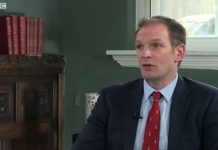Pay excluding bonuses rose by an annual 6.4% in the September-to-November period, the biggest increase since records began in 2001 excluding jumps during the COVID-19 period which were distorted by lockdowns and government support measures.
The ONS figures showed a wide gap between strong pay growth in the private sector and much weaker increases for public sector workers, many of whom are locked in wage disputes with the government and have carried out a wave of strikes.
Private-sector total pay rose by an annual 7.1% in the three months to November compared with 3.3% in the public sector, the ONS said.
Meanwhile there are some signs that the Labour market might be flattening
There were 1.161 million job vacancies on average across October to December 2022.
This was down 75,000 on the previous quarter, as employers continue to cite economic pressures
The unemployment rate remains at 3.7 per cent
The real value of people’s pay continues to fall, with prices still rising faster than earnings,” said Darren Morgan, director of economic statistics at the Office for National Statistics (ONS).
“This remains amongst the fastest drops in regular earnings since records began.”
Chancellor Jeremy Hunt said it was important to bring inflation down and not do anything that could further inflame it.
“The single best way to help people’s wages go further is to stick to our plan to halve inflation this year,” Hunt said in a statement.
“We must not do anything that risks permanently embedding high prices into our economy, which will only prolong the pain for everyone.”
Ben Harrison, Director of the Work Foundation at Lancaster University, a leading think tank for improving working lives in the UK:
“Today’s figures underline why we are seeing such a level of discontent amongst public sector workers, and why many continue to be concerned regarding the economic outlook for 2023.
“Inflation continues to cancel out wage rises with real pay down 2.6% on the year, and this is most harshly felt by the public sector workforce who are receiving increases of just 3.3% compared to 7.1% in the private sector. It’s vital that Ministers recognise the pressures facing public sector workers and urgently resolve pay disputes so that yet more days are not lost to strike action.
“The UK employment rate is 1.0 percentage points lower than before the pandemic and economic inactivity remains higher. While both main parties have begun to set out ideas to support more people into jobs, there is no magic tap to increase the size of the UK workforce or improve the quality of jobs on offer. Doing so requires long-term investment and reform, including more cross Government action to make employment services more inclusive and effective, and an Employment Bill to strengthen worker rights and protections.”







